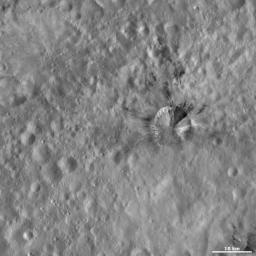Rubria Crater
Caption:
This Dawn framing camera (FC) image of Vesta shows Rubria crater, which is the crater with the dark and bright material, that is offset from the center of the image. Rubria's bright material mostly crops out of the rim of the crater and slumps towards the center. In contrast, Rubria's dark material is located outside of the crater rim in long streaks, as well as cropping out of the rim of the crater and slumping towards its center. The longest dark material streak that is still connected to Rubria's rim is located on the top part of the rim. But it is possible that the other streaks to the top of the rim, the farthest of which is approximately 15 kilometers (9 miles) from the rim, may also be associated with Rubria crater. Rubria is one of the freshest looking, and consequently probably one of the youngest, craters in visible in this image.
This image is located in Vesta's Gegania quadrangle, just south of Vesta's equator. NASA's Dawn spacecraft obtained this image with its framing camera on Oct. 22, 2011. This image was taken through the camera's clear filter. The distance to the surface of Vesta is 700 kilometers (435 miles) and the image has a resolution of about 63 meters (207 feet) per pixel. This image was acquired during the HAMO (high-altitude mapping orbit) phase of the mission.
Background Info:
The Dawn mission to Vesta and Ceres is managed by NASA's Jet Propulsion Laboratory, a division of the California Institute of Technology in Pasadena, for NASA's Science Mission Directorate, Washington D.C. UCLA is responsible for overall Dawn mission science. The Dawn framing cameras have been developed and built under the leadership of the Max Planck Institute for Solar System Research, Katlenburg-Lindau, Germany, with significant contributions by DLR German Aerospace Center, Institute of Planetary Research, Berlin, and in coordination with the Institute of Computer and Communication Network Engineering, Braunschweig. The Framing Camera project is funded by the Max Planck Society, DLR, and NASA/JPL.
More information about the Dawn mission is online at
http://www.nasa.gov/dawn
and
http://dawn.jpl.nasa.gov
.
Cataloging Keywords:
| Name |
Value |
Additional Values |
| Target |
4 Vesta |
|
| System |
Main Belt |
|
| Target Type |
Asteroid |
|
| Mission |
Dawn |
|
| Instrument Host |
Dawn |
|
| Host Type |
Orbiter |
|
| Instrument |
Framing Camera (FC) |
|
| Detector |
|
|
| Extra Keywords |
Crater, Grayscale |
| Acquisition Date |
|
| Release Date |
2012-05-14 |
| Date in Caption |
2011-10-22 |
|
| Image Credit |
NASA/JPL-Caltech/UCLA/MPS/DLR/IDA |
| Source |
photojournal.jpl.nasa.gov/catalog/PIA15650 |
| Identifier |
PIA15650 |

 Planetary Data System
Planetary Data System
